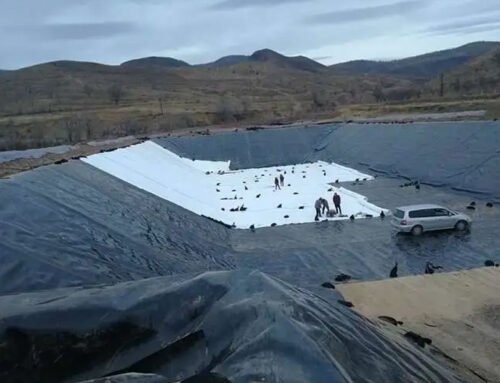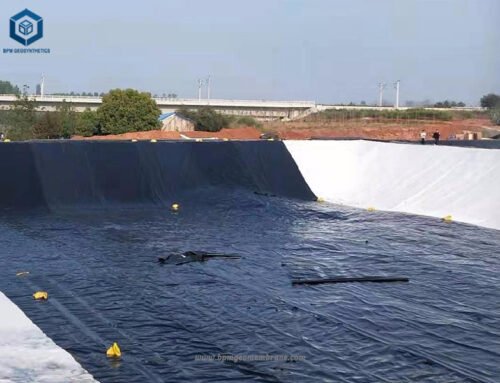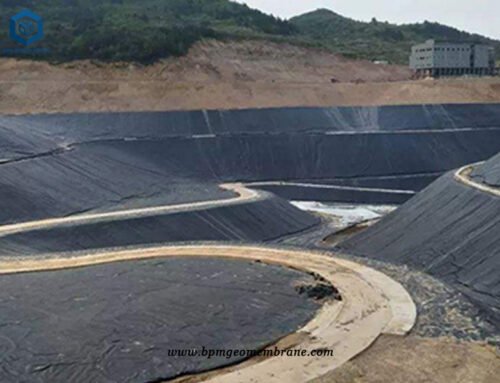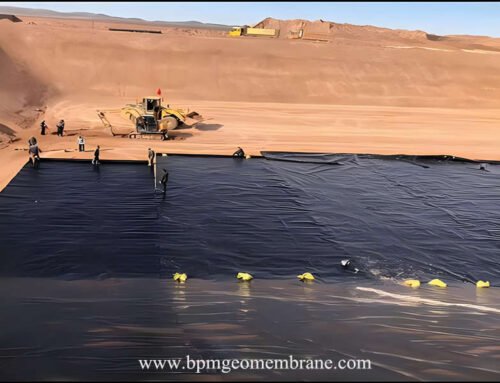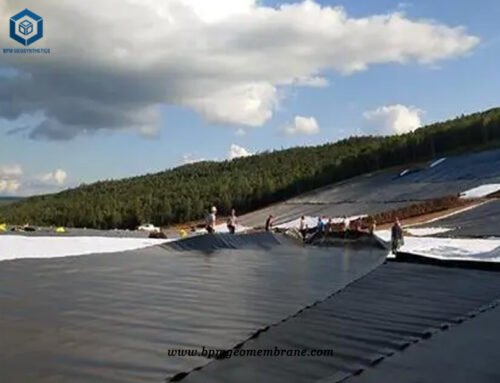Landfill Geomembrane, also known as landfill liner, is the most widely used geosynthetic products for solid waste containment (such as landfill liners), mining and water containment applications.
In landfill liner systems, the use of a 60 mil (0.06 inches) thick HDPE geomembrane made of high-density polyethylene (HDPE) is common. This thickness ensures a strong and reliable barrier against the migration of waste and leachate, providing effective containment and preventing environmental contamination.
The HDPE material used in landfill liners is selected for its extremely low permeability, meaning it has minimal passage for liquids or gases. This characteristic is essential to prevent the leachate, which is the liquid generated from the decomposition of waste, from seeping into the surrounding soil and groundwater.
1. What Is Landfill Geomembrane?
A landfill geomembrane, also known as a landfill liner, is a specialized type of geomembrane used in landfill construction and management. It is a synthetic barrier designed to prevent the leakage of contaminants from the landfill into the surrounding environment.
Landfill geomembranes are typically made of high-density polyethylene (HDPE) or other durable materials that exhibit excellent chemical resistance and impermeability. They are installed as a lining system in the landfill, creating a barrier between the waste and the surrounding soil and groundwater.
The primary function of a landfill geomembrane is to prevent the migration of pollutants, such as leachate (liquid waste) or gas, from the landfill. This helps to protect the underlying soil and groundwater from contamination. The geomembrane acts as a barrier, effectively containing the waste within the landfill and reducing the potential for environmental harm.
In addition to the geomembrane, a landfill liner system may also include geotextiles, geocomposites, and other geosynthetic materials that serve to enhance the liner’s performance and provide additional features such as drainage or gas collection.
Overall, landfill geomembranes play a critical role in modern landfill design and management, helping to ensure the safe and environmentally responsible disposal of waste materials.
BPM brand landfill geomembrane liners are manufactured using premium high-density polyethylene (HDPE) resins, ensuring the highest quality. These geomembrane liners come in various options, including black, green, or white upper surfaces, and can be produced with either a smooth or textured single or double-sided surface. Additionally, BPM offers the option of a conductive lower surface, which facilitates effective leak testing of the installed HDPE liner.
The use of BPM’s smooth and textured geomembrane liners provides reliable containment and protection in landfill projects. Their high-density polyethylene composition offers exceptional chemical resistance and impermeability, preventing the leakage of contaminants into the surrounding environment. By creating a secure barrier between the waste and the soil and groundwater, these liners play a vital role in safeguarding against environmental contamination.
BPM’s landfill geomembrane liners can be integrated into a comprehensive landfill liner system, which may include additional geosynthetic materials like geotextiles and geocomposites. These components enhance the liner’s performance, providing features such as drainage or gas collection.

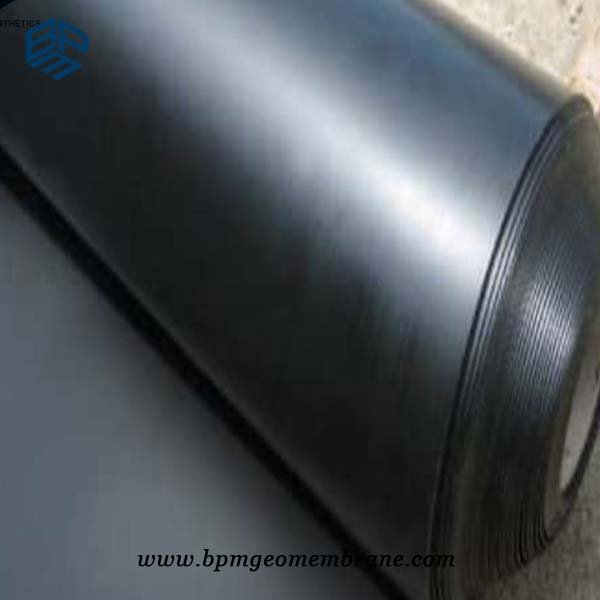
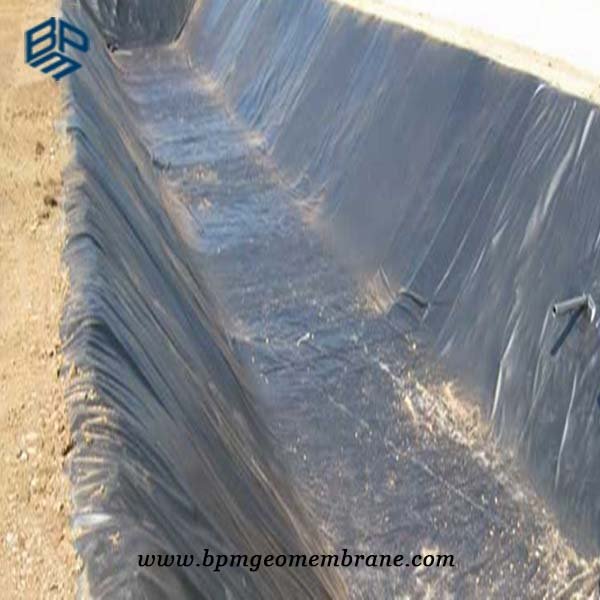
2. What Are Benefits of Landfill Geomembrane?
Landfill geomembrane provides essential benefits in terms of containment, environmental protection, gas emission reduction, durability, leak monitoring, and slope stability. Their use in landfill liner systems is crucial for maintaining proper waste containment and reducing the potential negative impacts on the environment.
2.1 Containment of Leachate
Landfill geomembranes, typically made of materials like HDPE, provide a highly impermeable barrier that prevents leachate, the liquid generated from waste decomposition, from seeping into the surrounding soil and groundwater. This helps protect the environment and prevents contamination of water sources.
2.2 Reduction of Landfill Gas Emissions
Landfill geomembrane can be used in conjunction with landfill gas collection systems to reduce the release of harmful gases, such as methane, into the atmosphere. By preventing the escape of gases, geomembranes contribute to better air quality and help mitigate the environmental impact of landfills.
2.3 Durability
Geomembranes are designed to be highly resistant to chemicals, acids, oils, and temperature fluctuations. They offer long-term durability and can withstand the harsh conditions present in landfills. With proper installation and regular inspections, geomembranes can provide a continuous, non-permeable barrier with a long service life.
2.4 Leak Monitoring Capacity
Landfill geomembranes can be integrated with underlying drainage and leak detection systems. This allows for proactive identification of any breaches or defects in the liner. By monitoring for liquid capture, potential failures can be identified and repaired before significant damage occurs, ensuring the continued integrity of the barrier.
2.5 Slope Stabilization and Erosion Protection
Geomembranes can also contribute to slope stability in landfill structures. They can be designed with physical projections or structures that aid in stabilizing steep slopes. Research has shown that geomembranes can help reduce runoff and dissipate the impact of raindrops, thereby preventing erosion and potential slope failures.
3. Case Study of Landfill Geomembrane Project In Canada
The landfill geomembrane project in Canada was initiated due to the accumulation of garbage around the main river in the city, causing widespread disgust among the residents. Recognizing the environmental concerns, our Canadian customer actively collaborated with the local community and the regional Conservation Authority to develop an effective and sustainable leachate management program. During the course of our discussions with the customer, we recommended the utilization of our landfill geomembrane liner as a suitable solution.
BPM’s geomembrane landfill liner, renowned for its quality and reliability, is extensively employed across various industries such as landfill management, waste containment, water containment, aquaculture, industrial projects, energy projects, and mining projects. Its versatility and effectiveness make it an ideal choice for diverse applications.
Upon the completion of the landfill geomembrane project, we received highly satisfactory feedback from our customer. The implementation of our landfill geomembrane liner proved instrumental in efficiently managing the leachate and preventing the contamination of the surrounding environment. This successful project underscores our commitment to providing top-quality products and meeting the specific needs of our customers in Canada and beyond. We are proud to contribute to environmental sustainability by offering effective solutions for waste management and containment.
4. Specifications of HDPE Landfill Geomembrane In Canada
The HDPE landfill geomembrane liner specifications for the project are as follows:
- Total geomembrane liner quantity 20,000 m2
- Each roll size 4.5m*50m
The project requires a total area of 20,000 square meters to be covered with the HDPE landfill geomembrane liner. The liner will be supplied in rolls, with each roll measuring 4.5 meters in width and 50 meters in length. These specifications ensure efficient and convenient installation, allowing for effective containment and protection of the landfill site.
5. About BPM
BPM Geomembrane had provided many types of effective and states of the art geomembranes, geotextile and other geosynthetics to over 36 countries. Our main customers are from Australia, France, Sweden, UK, Hong Kong, Hungary, New Zealand, Poland, Mexico, Ecuador, Brazil, Pakistan, Bangladesh, Thailand, Vietnam, Malaysia, Indonesia, Singapore, Philippines, Sri Lanka, India, UAE, Saudi Arabia, Qatar, Kenya, Ghana, Ethiopia, Somalia, Nigeria, South Africa, Swaziland, Mongolia etc.
BPM is also providing professional design and installation service. OEM and ODM are also available. If you have any questions or inquiries, please contact us, we will reply as soon as possible.

